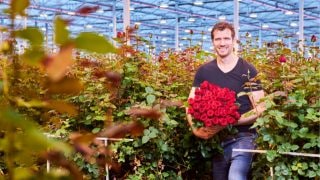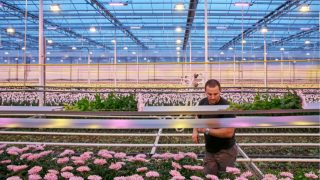Even though chrysanthemums are one of the most popular cut flowers, the use of LED grow lights for their cultivation in greenhouses has been limited. Philips has done much research on these plants over the years, but had not been able to test the perfect light spectrum on a large scale until recently so it was hard to justify the investment to growers. Recent research results, however, may change grower’s minds on this subject.
Proven: LED grow lights deliver stunning chrysanthemums
Heavier stems or more plants per square meter
The challenge with using LED plant lights to grow chrysanthemums stems mainly from the fact that they are short-day plants. The flowering of these plants is triggered by the shorter days of late summer. This occurs either naturally outdoors in late summer or can be artificially controlled in a greenhouse by withholding light for 11 to 13 hours each day, for a period of 8 to 9 weeks, depending on the variety or type of chrysanthemum. This technique allows growers to control the flowering of chrysanthemums and make them available for sale any time of year.
Philips has carried out many research trials over the last years to find the ideal light spectrum for chrysanthemums. In 2016 the two best light recipes were tested in a large-scale pilot with research partner Arcadia, a leading commercial grower of de-budded chrysanthemums in The Netherlands, and the results are impressive. Arcadia worked with Philips to test these two light recipes that came out of previous trials and to gain knowledge in growing with LED.
The pilot project started in October 2016 on 2,000 square meters of chrysanthemums. The shared goal of the pilot was to verify if the results of the small trials worked on commercial scale and see which light recipe would perform best on a larger area. Several varieties of chrysanthemums were grown over one year in a hybrid installation of Philips GreenPower LED toplighting and Philips HPS (high pressure sodium) lighting. Philips set up the specific light recipes for growing chrysanthemums for this project and the results were closely measured in collaboration with Arcadia’s growers.

This trial yielded some surprising results with one light recipe in particular. The LUE (Light Use Efficiency) was shown to be higher under the hybrid installation, meaning chrysanthemums make very efficient use of light from LEDs. Two different LED spectra were tested and there were big differences in how they influenced the plants. The chrysanthemum stems were much heavier when grown under the best light recipe. These results actually prove that added value of LED lighting, which was found in the previous smaller trials, does exist.
Commercial growers have been waiting for a large scale confirmation of an effective LED light recipe, which is exactly what we achieved at Arcadia. With this chrysanthemum light recipe, growers can either use a hybrid installation to grow heavier stems or put more plants in a square meter to increase yields.
This trial was based on LED and HPS lighting, so the next step for Philips is to search for a 100% LED light recipe for chrysanthemums. We have seen promising results with chrysanthemums grown in a small trial of 100 square meters with 100% LED at the HAS (University of Applied Sciences) in ‘s-Hertogenbosch, The Netherlands. We set up this trial with the support of the Delphy Improvement Center and some commercial chrysanthemum growers. The results with LEDs alone have already produced very nice branches on the plants and research will continue.
When you add up the growing body of evidence, the business case for growing chrysanthemums under LED plant lights is strong. In fact, based on these results we are looking at new LED installations for a number of chrysanthemum growers. The first commercial project with Philips LED lighting was sold earlier this year to Linflowers in Brakel, The Netherlands. They chose to partner with Philips lighting to add 48 µmol/m²/s LED growing lights to their existing HPS installation for an area covering 37,152 square meters. These steps forward confirm that the close collaboration between growers, researchers and Philips is the right formula for finding the right light recipe.

Stefan Hendriks is a Plant Specialist at Philips Horticulture LED Solutions. He spends his day defining the best LED growth recipes for floricultural plants. His work involves developing the perfect light recipe (light spectrum, intensity, lighting duration) in combination with the ideal climate settings. Stefan works together with business owners, growers and researchers to better understand LED applications and thereby develop the best horticultural solutions.
Related articles
Contact us
Contact certified partners
Philips products are sold through a global network of certified partners. Find partners in your region for more information about Philips LED grow lights.
Contact Philips
What are the best LED grow lights for your situation? We are here to help. Please use our form to submit your request.
Subscribe to newsletter
Keep up to date about Philips LED lighting in horticulture by subscribing to our newsletter.
Join our team
Interested in discovering your recipe for growth and joining our team? Take a look at our career page for more information.
Interested?
Learn more about LED lighting in horticulture by reading our latest articles and case studies.



